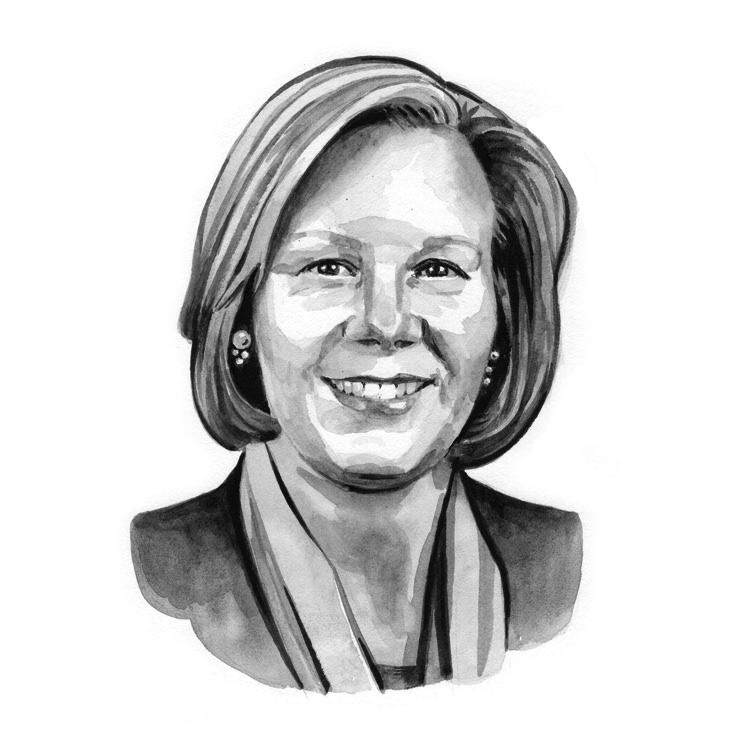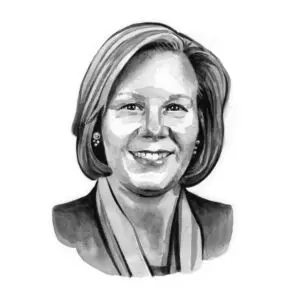CPP Investments recently spoke to a range of diversity and inclusion experts to find out how women were faring in the COVID-19 era workplace.
Gathered here are short outtakes from some of those conversations, in which these experts argue passionately for the kinds of changes that could preserve the progress Canada has already made toward equity in the workplace and allow a new generation of women to make further gains.

Tanya van Biesen, Senior Vice President, Global Corporate Engagement, Catalyst on the imperiled pipeline for female talent.

Sarah Kaplan, Distinguished Professor and the Director of the Institute for Gender and the Economy at the University of Toronto’s Rotman School of Management on the need to invest in childcare.

Camilla Sutton, Former President & CEO, Women in Capital Markets on fixing the system, not the person.
Tanya van Biesen is the Senior Vice President, Global Corporate Engagement for Catalyst, an international organization devoted to accelerating the progress of women through workplace inclusion.
The imperiled pipeline for female talent
The pipeline for female talent is under threat. If we want Canada to return to pre-COVID economic health, then we need to get women back to work. We need to get them back in their jobs. Right now, my deepest concern is that that’s not going to happen because many sectors are not going to return to normalcy any time soon, most notably those sectors like hospitality and travel where women occupy most of the frontline positions.
Part of the problem is that women are over-represented in highly vulnerable roles, so, it’s not clear they will ever return to the jobs they had. But it’s really important to unpack the data.
If you look at current unemployment levels, women have a lower unemployment level than men do, but, if you look further, the data shows that more women have exited from the job market permanently since the start of the pandemic than have men.
And this is likely to get worse. A recent survey, conducted by Pollara Strategic Insights on behalf of The Prosperity Project, revealed that over the course of the pandemic, 30% of women have considered leaving their jobs versus fewer than 20% of men. And so there is a real danger of permanent scarring here, and that is true across all levels of organizations.
That will dramatically impact the pipeline if we don’t get these women back into their jobs or if we lose even more. I recently spoke with Tina Lee, the CEO of T&T Supermarket. She has seen many of her workers exit the workforce, but the return rate now is higher among men. Why? Because women still carry the lion’s share of the household burden, be that childcare, elder care, just running a household in general. And doing those things in what feels like an unsafe health environment and certainly a precarious childcare and school environment is very, very difficult.
This is not something that will be resolved in the next few months. A widely available vaccine is probably 18 months to two years away. If women are out of the job market for that length of time, they risk permanent damage to their careers because they will lose skills and the job market will have moved on.
Reskilling happens at school and it happens at work. If you’re not in one of those two environments, it’s just much harder to keep up or catch up. We need to support women so they can return to the workplace now.
Caroline Codsi, is founder and president of Women in Governance, a non-profit organization dedicated to helping women rise to leadership positions in organizations and on their boards.
Quotas
I’m a believer in legislated quotas for female representation on boards. Look at what has been done in Europe. Scandinavian countries legislated to require 40% women on their boards and they attained that goal very quickly. France made some very stringent demands and considered delisting companies from the stock exchange that didn’t comply but in the end didn’t have to do it.
Companies at first were upset and felt like this was an intrusion into the way that they were managing their business. But then they quickly realized that it wasn’t that hard,
that the women were out there and that they were capable. Just look at education. Sixty percent of university graduates are women. These companies in France turned something that was imposed on them into something that they actually wanted to do.
What do we always hear in Canada? “We can’t find any women.” It’s absurd. Because when you legislate, suddenly you find qualified women. When you don’t legislate, you find excuses. We have one province in Canada, Quebec, that in 2006 legislated for crown corporations to have 50% women on their boards. And you know what? They obtained their objective within five years and have been sustaining it ever since.
So to me, the fact that in Canada, we still don’t understand the value of legislation is a problem. There’s a lot of research that demonstrates that setting a target is actually the best way to reach a goal and to see whether you are progressing or not. We keep saying it’s all going to happen naturally but, look around you. Only 5% of CEOs of major corporations in Canada are female. We need to stop thinking that it’s the women who are not ready, the women who are not willing. We need to enact some legislation that will finally bring gender equity to the boardroom.
Women in Governance is empowering women and closing the gender gap using the Women in Governance Parity Certification. Certification starts with a thorough diagnostic of an organization’s position on the gender parity spectrum as it pertains to the strategies (culture and commitments) and actions (communications, policy and programs) and the results they yield. Following the assessment, the customized report outlines best practices and the key drivers to enable an organization to build a roadmap to gender parity.
Sarah Kaplan, Distinguished Professor and the Director of the Institute for Gender and the Economy at the University of Toronto’s Rotman School of Management.
The need to invest in childcare
We have not made much progress in the last 30 years on gender equity. In fact, it’s been embarrassingly small given the amount of attention that has been paid to these issues. So, we have to try something different. Investing in childcare is one way to do that. Right now, women who have risen in their careers and have school-aged children are being told by their employers that they need to come back to work. And they are having to choose between their jobs or being able to take care of their children, who are either going back to school part-time or being schooled at home.
This hits women at all levels extremely hard. We’ve already seen that women were more likely to be laid off during the pandemic and much less likely to be rehired. We’re now going to see a second wave, a mass exodus of women from the workforce due to childcare. Employers are going to force women to choose between work and caring for their children. They’re going to put all of the choice on the employee and they’re going to blame women for having made that choice as opposed to understanding that their corporate processes are making it impossible for women to maintain full employment. And I say “women” in particular because in Canada, which has very traditional gender norms, women are the ones who are doing the dominant amount of the additional care work that has been created by the pandemic.
It’s a huge crisis. We are going to see a massive loss of women — especially women in that mid-tier of leadership because they’re the ones with the school-aged children. They will either leave the workforce or take a different kind of role that will not put them in a position to rise up to the top of the organization. I see it as a crisis unless companies take some steps. The first thing they can do is rethink the return to the office. There are far too many employers who are mandating a return to physical work, even though we have discovered over the past six months that employees can be perfectly productive working from home and may need to work from home because of caregiving responsibilities.
The second thing that corporates could do is provide on-site daycare or childcare, so that if employees can’t send their children back to school, they can bring them to work. We know that a lot of daycares have closed or gone bankrupt through this process and so what was already a shortage of daycare slots has only gotten more intense. Employers will need to fill the gap and provide childcare for their employees. On the government side, there needs to be heavy investment in childcare and in safe schools because if children cannot be taken care of safely, parents are going to be forced to stay home. We have historically underinvested in childcare. The OECD benchmark is 1% of GDP spending on childcare, and Canada isn’t remotely close to that. It’s time for that to change.
Leading the way to gender equity
The tone at the top of an organization is just so important. It can’t be just about words. It has to be about actions. To accelerate the climb of women into leadership roles you have to have individuals at the top who model what you expect. Leaders need to live the values they talk about.
I believe in the idea that if it’s not measured, it’s not valued. In our firm, that means we have specific KPIs and compensation for our leaders associated with making sure we have a full pipeline of women and minorities. This affects the pay and performance metrics for all leaders in every part of our organization. I really force people to look at their leadership ranks, in every region. Are the numbers where we want them to be? We challenge every hire and every appointment. We apply a lens to make sure that we’re making the right decisions. We need leaders to build a pipeline that is reflective of our society. That’s what I expect and that’s what I make sure all of our leaders are clear on.
I do this because gender equity is not a women’s issue – it’s an issue for all of us to solve. All leaders, especially all senior leaders, need to believe in this. I expect our leaders to be mentors and to really sponsor female talent. As a sponsor, you actually help shape, help drive and help organize how that individual makes her way through the organization. A lot of it is coaching and making sure they’re getting challenged and getting opportunities to learn and advance. So it is a deliberate and thoughtful approach. You also have to be honest. You have to give real and authentic feedback, but you also have to be ready to take their feedback in return. It comes down to developing a trust relationship.
Doing all this means we’ve become something of an academy firm for women. We bring along a lot of female leaders and then what ends up happening is everybody wants them. These women get offered great career opportunities. A number of our great women leaders have been recruited by other companies. They double their salaries and accelerate their progress. What do you do when that happens? You celebrate, because you gave them a great opportunity and a chance for career advancement, and you hope that someday you get them back with great new skills. But that also comes back to the pipeline and making sure you are developing that next generation of women leaders and that you have a good succession plan. So it’s a challenge in our organization, but it’s a good challenge and I think it’s also why a lot of great female talent comes to us. They see that opportunity.
Karen Sihra is Director, Inclusion & Diversity at CPP Investments, an investment organization managing a resilient, globally diversified portfolio to help ensure the Canada Pension Plan is there for generations to come.
Inclusion
Inclusion, diversity and equity are three pieces of the same puzzle. Inclusion is about how people feel when they come to work. Do all colleagues have an opportunity to be their best selves and unlock their professional possibilities? Are we allowing them to experience an organization that supports, respects and values them as individuals, and their unique contributions?
I often say that inclusion is easy with a homogenous group of people. Endless research has demonstrated that diversity contributes to better performance through hedging against groupthink by incorporating diverse perspectives and life experiences, and by identifying blind spots in decision making. In the absence of inclusion, these contributions are limited – and may not surface at all. We need to be thinking about how to bring that diversity to the table to unlock all inputs from all our colleagues collectively.
Another issue is ensuring a fair organization, where we are looking at people’s capabilities and capacities to do the work and are not jaded by what we think might fit into historical norms. When we think about equity specifically, we’re really thinking about the types of tools and resources we provide to colleagues to ensure that they are unlocking their professional possibilities and contributing, to the best of their abilities, to the organization’s success.
Building a supportive organization requires all colleagues’ engagement. It’s easy to say we want diverse representation but there needs to be an equal focus on the experiences of those colleagues when they come into the organization.
No one wakes up in the morning and says, “I’m going to live my life as this ‘other.’” It’s not until someone makes them feel this way – either in a particular moment or through a lifetime of othering signals – that they have this experience. It is a real call to action for all colleagues to create that inclusive experience for one another.
For example, how are women feeling when they begin sharing an idea and men start speaking over them? Likely, that their opinions aren’t valued or that their judgement and decision-making capabilities aren’t seen as equally significant to their male colleagues’. The onus in this scenario is not simply that women shouldn’t speak up, send an email instead, or present themselves differently. It is to ask those interrupting to cease the non-inclusive behaviour and build better habits of inclusion.
We have several programs in place that help support this mandate. We’ve identified concepts like humility, empathy and authentic curiosity as core behaviours to build and sustain our inclusive workplace. Really strengthening that muscle will make us a better place for all colleagues, including historically underrepresented groups.
Camilla Sutton is the former president and CEO of WCM (Women in Capital Markets), an organization devoted to accelerating diversity in the financial industry.
Fixing the system, not the person
The progress that we have made as an industry in gender equity has been relatively limited, particularly in the area of executive capacity. I think real progress requires that we stop trying to fix the people and we start trying to fix the system.
That’s a really big change from where we’ve been, with mentorship programs for women and all these other programs geared towards women or racialized people. It means instead, let’s look at the bias inherent in our system and let’s find ways that we can weed that bias out. It means that you work very hard to build equity literacy and you eliminate harassment and discrimination. You look at your complaint mechanisms, and you increase transparency measurement, monitoring, reporting.
Inclusion doesn’t happen just by bringing women or racialized people into your organization; the work is long-term and requires a very deep understanding of equity. We need to de-bias the process and policies as opposed to focusing on de-biasing the people. So, for instance, when you look to hire, make sure you get a diverse candidate pool and once that diverse candidate pool is in front of your diverse hiring panel, make sure you have standardized questions so that you can no longer build that informal relationship of, “I work out at the Cambridge Club”, “Me too, don’t you love so-and-so’s class?”
One of the biggest takeaways from the COVID experience is that our minds are incredibly closed. If anyone had suggested that the whole investment community was going to work from home for the next six months and make that switch over the space of two weeks, I would have said it was impossible. Everybody would have said it was impossible, and lo and behold it was possible and in fact effective. I think that experience highlights how closed our minds are to new ideas and new concepts about work environments. Even when we think we’ve been incredibly innovative, we really haven’t. We really haven’t been pushing outside the box at all.
Sarah Williamson is the CEO of FCLTGlobal, a non-profit organization that develops research and tools that encourage long-term investing and business decision-making.
Using data to promote gender equity
When I worked on Wall Street, I was in a meeting to decide which candidates would be promoted. There was one guy who was right on the bubble. His performance was good, but it wasn’t great. Finally, one of the guys said, “So-and-so is a great fisherman,” and what he meant was, “We respect his ability to catch fish, he’s got a big boat, he’s kind of cool, he’s one of the guys.” And I looked at him and said, “But we’re not in the fishing business.” That kind of stuff happens all the time. Can you imagine the guffaws if I had said of a female candidate, “but she’s great at ballet or a great seamstress?”
So I think the metrics are really important. To increase diversity, you have to be really serious about it. You’ve got to understand what the problem is and measure it. I think most people want a level playing field, but in my experience, people have really resisted numbers, targets, or quotas in this area. And I will admit I started out in that same place, thinking, “Oh, time will take care of it.” The truth is, the data does not support that.
I’m a big believer in incentives. If you tell managers they should meet a goal, but you don’t incorporate that into their promotion metrics or pay, then you’re telling them it doesn’t really matter. If you’re not hiring or promoting enough women, the answer isn’t to say, “Well, we couldn’t find any.” Well no, you’ve got to do more to attract great female candidates. You’ve got to figure out what’s not working.
There’s a well-known example from Harvard Business School. They had started admitting women in numbers, but the men were basically doing better in terms of grading. Some people thought they were just letting in women who weren’t as strong. Some people thought the male teachers were just being jerks. They had all these theories. When they looked deeper, it seemed to come down to class participation. A lot of the grading at Harvard Business School is about how much you speak and the points you make.
They decided to really diagnose the problem so they recorded the classes and compared the transcripts to the teachers’ note and what they learned was that the women were speaking up just as much as the men but the teachers, both male and female, were not giving as much weight to their comments.
The point is that you need to figure out what your problem is and measure it. If you have a pipeline problem, you may be recruiting from the wrong schools. Or maybe you’re going to the right schools, but only getting to a sub-group within that school. So you’ve got to test and see which it is. If you’re looking to hire a racially diverse group but you only interview 20 white people, that’s going to be a problem. Or maybe you’re bringing in young people who are very diverse but then you lose them at some point. Or maybe you channel them into service or support jobs that don’t lead to an executive career path. I think that the main thing is understanding what the problem is and going after that. Because obviously if you solve the wrong problem, it’s not going to work.
















